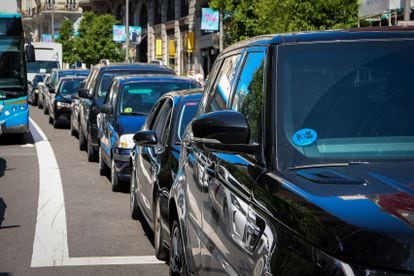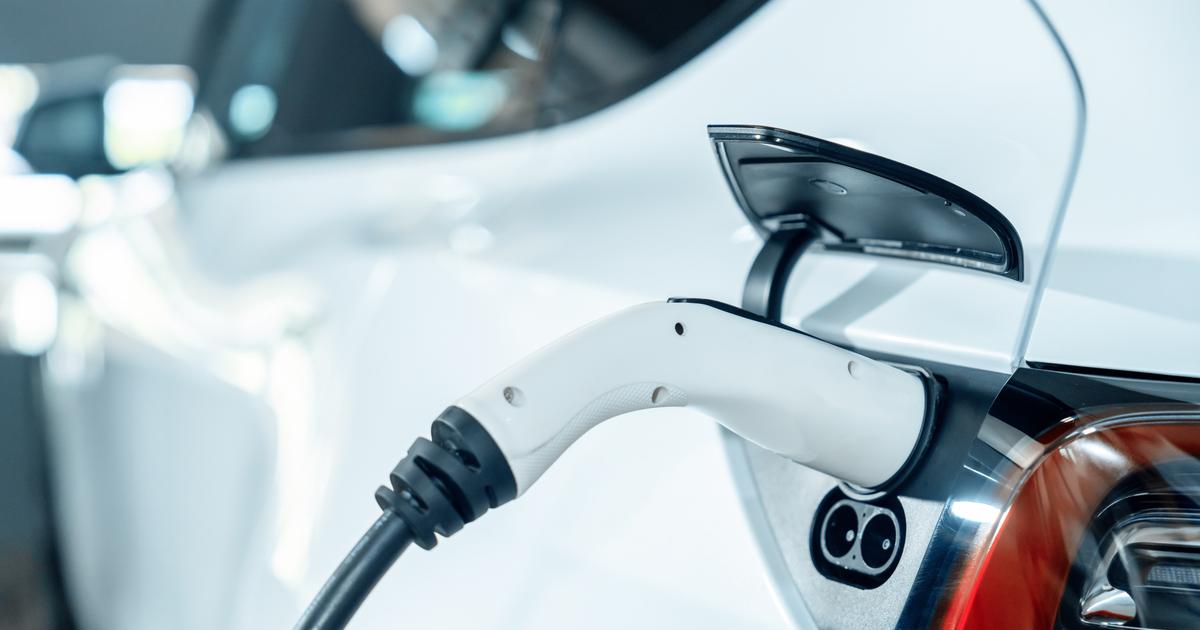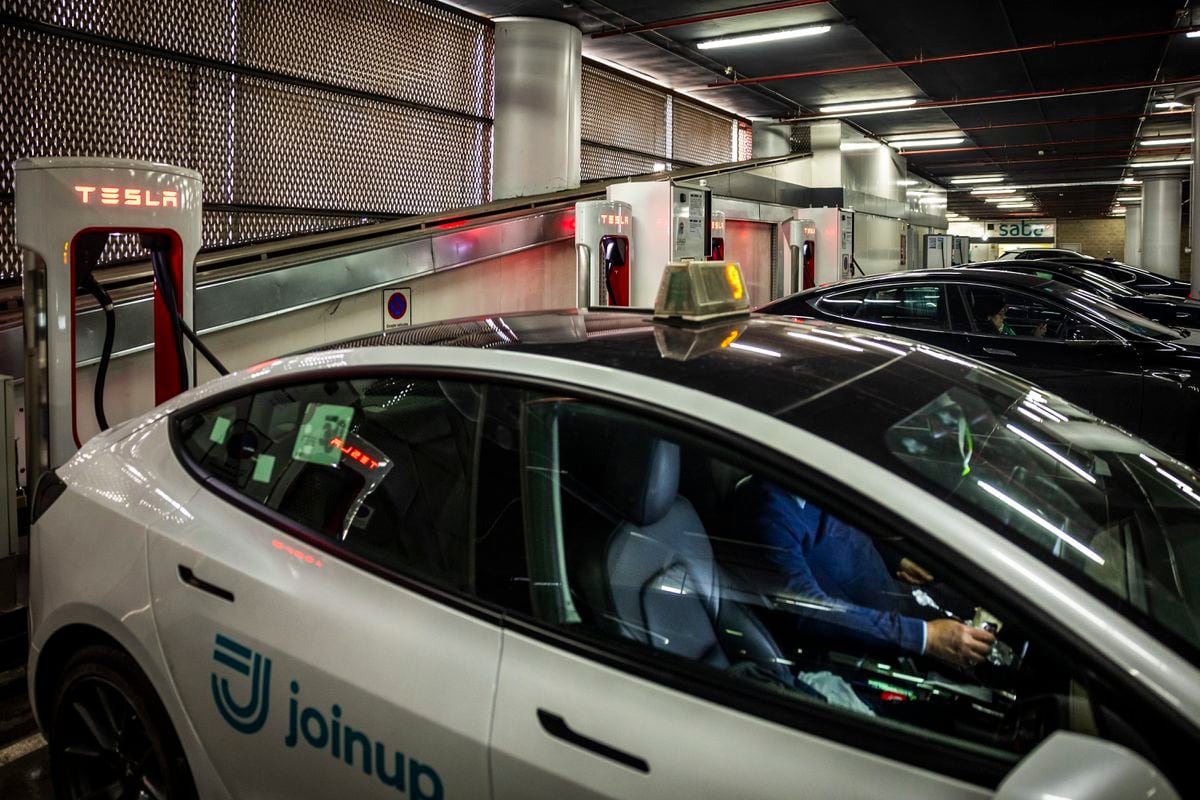An SUV with a zero label, which is granted to hybrid cars that can circulate with a combustion engine. KIKE PARA
The Government promised in June 2020 to reform the environmental label system of the General Directorate of Traffic (DGT), which classifies vehicles according to their polluting emissions, within a year and replace it with a more appropriate one.
However, at the end of 2021 the Ministry of the Interior —which led the interministerial group for this reform— shelved the work without explanation.
The department on which the DGT depends does not show the report to reject this measure despite the fact that EL PAÍS has requested it by Transparency, nor do the other ministries involved provide it.
Environmentalists denounce that the current classification grants ecological stamps to circulate in low-emission zones to highly polluting vehicles and accuse the industry of pressuring to stop the change,
something that the manufacturers deny.
Meanwhile, Germany has announced that it will remove incentives for plug-in hybrids and keep them only for pure electrics.
"The current system started in 2016 and serves to discriminate positively against the most environmentally friendly vehicles," explains a DGT spokeswoman.
In it, gasoline cars registered before 2000 and diesel before 2006 lack a label (although it would be an A).
Label B corresponds to gasoline cars between 2000 and 2006 and diesel cars from 2006 to 2013. Label C corresponds to gasoline cars after 2006 and diesel cars after 2014. Eco: hybrids in general.
Zero: electric or hybrid with a range of more than 40 kilometers.
These labels are the basis for applying restrictions in low-emission zones such as those that the 149 towns with more than 50,000 inhabitants must create this year: the most polluting vehicles cannot enter,
More information
What air do the children of Madrid and Barcelona breathe?
In 46% of schools the permitted contamination is exceeded
The current model is based on the Euro standards, which measure emissions of nitrogen dioxide (NO₂) and particulate matter (PM) —pollutants that cause pollution in cities— but not carbon dioxide (CO₂) —main greenhouse gas—“The label does not take into account the displacement, weight or power of the vehicle, so there are inconsistencies such as there are huge SUVs [SUVs] that just because they have a backup battery have a better label than a gasoline utility vehicle, which pollutes much less”, criticizes Adrián Fernández, from Greenpeace.
Fernández gives several examples that squeak, such as a 680-horsepower plug-in hybrid SUV with only 40 kilometers of autonomy that receives the zero label, despite the fact that it emits more than 92 grams per kilometer (g/km) of CO₂.
“The DGT classifies vehicles with a combustion engine and exhaust pipe as zero emissions.
In addition, the figures for this SUV are for a combined use of gasoline plus electricity, but nobody guarantees that they will not circulate only with the gasoline engine and the battery discharged, ”he denounces.
“Even within the same model, inconsistencies are observed.
A diesel Seat León consumes 4.5 liters per 100 kilometers (l/100) and emits 120 g/km of CO₂.
The same Seat León in a hybrid version consumes and emits more (5.7 l/100 and 131 g/km of CO₂) but has an Eco label, while diesel has a C label, which is worse”, he continues.
Proposal to reform the environmental labels of the DGT made by five environmental organizations.
Transport & Environment
To solve these problems, the environmental organizations Ecodes, Ecologistas en Acción, Greenpeace, Fundación Renovables and Transport & Environment (T&E) made a joint proposal to the interministerial commission that, in addition to the Euro regulations, includes a maximum threshold for CO₂ emissions.
Carlos Bravo, from T&E, explains it this way: “The zero label should only be for electric batteries and battery cells, which are those that do not emit CO₂.
The Eco label must go because it is misleading.
Hybrids, plug-in or not, would enter another new category, D, in purple.
Those hybrids that exceed 95 g/km of CO₂ should go to C. All gas vehicles emit more than that amount, so they would go from Eco to C or B. There are people who believe that driving a car with gas are ecological,
Adrián Fernández intervenes: “The newest Euro standards (Euro 5 and Euro 6) reduce the local emissions of the vehicle.
A Euro 6 diesel has a microparticle filter and a catalyst, which greatly reduces pollutants such as NO₂.
But CO₂ is a result of combustion, you can't filter it.
And it is more linked to fuel consumption.”
In addition, the Government uses these labels to promote decarbonisation in cities through low emission zones, something that is not achieved if vehicles continue to emit CO₂.
industry pressures
Environmentalists accuse the car industry of pressuring ministries to prevent the reform.
“Since not enough electric cars are being sold yet, manufacturers are interested in continuing to sell polluting cars with the Eco label, which can also avoid the new low-emission zones,” criticizes Bravo.
A spokeswoman for the Spanish Association of Automobile and Truck Manufacturers (Anfac, the sector's employers' association) denies these accusations: “Anfac did not participate in the interministerial commission nor was any consultation procedure opened.
We understand that the consensus of all the agents involved has been to maintain the current system, which works and it is essential that it be consolidated, without questioning its effectiveness so as not to generate greater uncertainty”.
In her opinion,
The Executive himself was already aware of these problems in the Plan to promote the automotive value chain that he presented in June 2020: "The current labeling system has allowed an increasingly well-known classification of the vehicle fleet, and contribute coherence to state, regional and local policies based on the polluting potential of vehicles.
However, technological evolution is a reality and the new vehicles that incorporate these innovations should be cataloged within the possibilities offered by the current label system, or by adding new labels”.
In fact, the Ministry of Ecological Transition, which participated in the interministerial commission together with Industry and the Interior, opens the door for this reform to be carried out in the future: "It is not ruled out that later it could receive a new impetus after make a first balance and check if the system needs to be modified and take into account criteria such as CO₂ emissions.
In any case, if this subsequent review were carried out, it would be done jointly with the Ministry of the Interior and the DGT,” says a spokeswoman.
Interior of a vehicle with an Eco label. KIKE PARA
Apart from all this, the truth is that the criteria for rejecting this reform now remain hidden.
The Ministry of the Interior has refused to provide the report it presented to the Council of Ministers on October 11, despite the fact that EL PAÍS, as well as environmental organizations, have requested it through the Transparency Portal.
Fernando Grande-Marlaska's department responds: “The content of said report cannot be made available as it forms part of the secrecy of the deliberations of the Council of Ministers [...].
In any case, due to the general difficulties and uncertainties at the moment, and in order to allow the new low-emission zones to do so on a consolidated and stable model, it has been made publicly clear that the group's work will not continue in the present legislature”.
A similar framework in Europe
Germany, France, Denmark and Austria have environmental labels very similar to the Spanish, that is, based on the Euro system and with colours, although the categories are not exactly the same.
Germany, the European country that manufactures and buys the most cars, has labels of three colors (red, yellow and green) and cars with a red label cannot access the 58 German low emission zones.
Although they are not considering reforming the labels there, they are preparing to eliminate the aid that favors the purchase of plug-in hybrid cars,
reports Elena Sevillano
.
The Government considers that these vehicles do not require incentives to promote their purchase.
Plug-in hybrids are heavily criticized for not being green enough.
German environmental associations argue that in general very little is circulated in electric mode.
This may open the door to change throughout Europe.
The German Executive is also studying reducing in the next two or three years the aid to buy pure electric cars, currently subsidized in Germany with up to 9,000 euros.
The objective of Olaf Scholz's Executive is to progressively cut aid until it is completely eliminated by 2025. In recent years, the purchase of these plug-in vehicles has skyrocketed.
In 2021, the German government allocated 3.1 billion euros to this type of subsidies.
It received more than twice as many requests as the previous year (more than 600,000), according to data from the Ministry of Economy.
You can follow CLIMA Y MEDIO AMBIENTE on
and
, or sign up here to receive
our weekly newsletter
Exclusive content for subscribers
read without limits
subscribe
I'm already a subscriber









